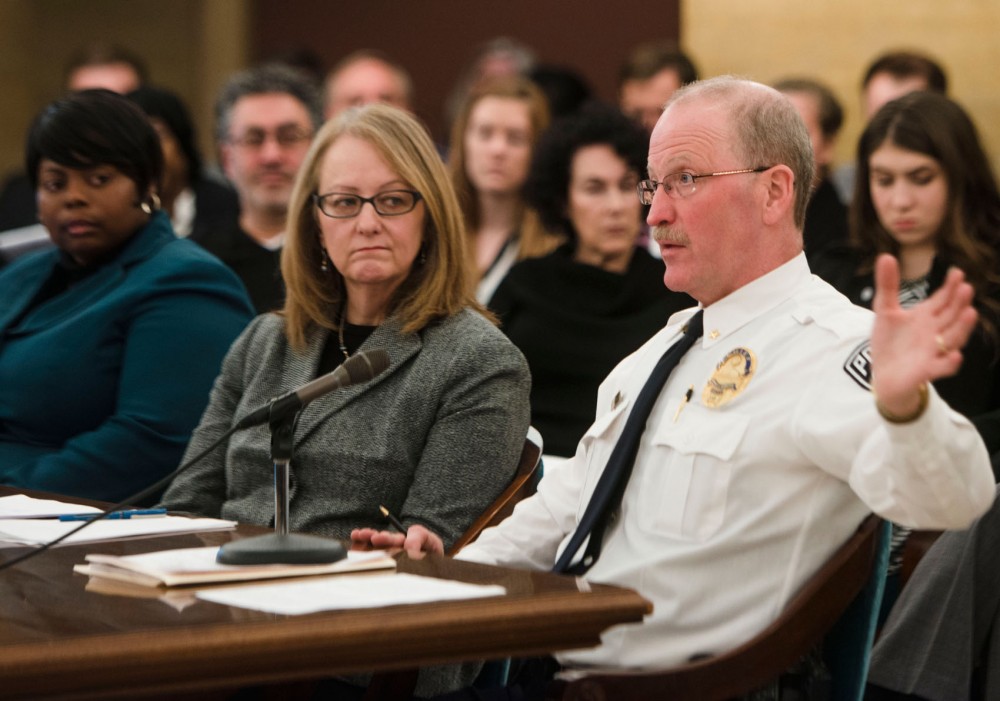University of Minnesota and law enforcement officials met with state legislators Tuesday at the Capitol to discuss campus safety amid a series of violent crimes in the area.
“We feel targeted, and we do not feel safe,” senior Sara Gottlieb said to the panel of state legislators.
The Senate Higher Education and Workforce Development Committee held the meeting to hear students’ concerns, allow law enforcement officers to share practices and ensure the state provides ample resources to address the issue.
Committee Chair Sen. Terri Bonoff, DFL-Minnetonka, said while higher education institutions in metro areas have dealt with fluctuating crime trends for decades, the recent uptick is unique because of the criminals’ boldness.
University police have issued 14 crime alerts since the beginning of the semester for crimes, which include two sexual assaults, an attempted kidnapping and many armed robberies.
“I think it’s very troubling that a handful of thugs have been able to disrupt our community to the degree they have,” University President Eric Kaler said, “and we’re aiming to put an end to it.”
Vice Provost for Student Affairs and Dean of Students Danita Brown Young testified at the meeting and said the string of University crimes is worrying current and prospective students, though crime on or near the University campus has been decreasing for years.
“We are very concerned about the perception that our campus is not safe,” University Services Vice President Pam Wheelock said at the meeting.
Gottlieb and sophomore Rachel Sadowsky, both Spanish and Portuguese pre-med students, said they are concerned about criminals from outside the campus area targeting students. They created an online petition late last month to increase police presence on or near the University campus.
“We’re doing our best to be aware of our surroundings and to maintain our personal safety, but concern for our security on a daily basis has interrupted the flow of our normal lives,” Sadowsky said.
‘Times are changing’
At the meeting, Wheelock emphasized that crime prevention strategies must evolve with time.
With increased rental housing near the University, completion of the Central Corridor light rail and more students carrying smartphones, she said, law enforcement officials need to re-evaluate how they address crime.
“It’s just a matter of identifying the trend — which we have — and placing those areas with additional resources,” Minneapolis police Deputy Chief Ed Frizell said.
He said he thinks there are currently enough forces on the ground in the University’s surrounding neighborhoods.
Hennepin County Sheriff Richard Stanek said that since this time last year, Minneapolis has seen a 12 percent increase in robberies, reflecting a nationwide trend.
He said iPhone, iPad and other mobile device theft, known as “apple picking,” is rising across the country and is common on college campuses.
“Criminals seek out urban areas where there is a lot of foot traffic, places where they can get in and out quickly and where they have a lot of potential victims,” Stanek said. “Urban college campuses fit with this model.”
Ward 5 City Councilman Don Samuels said cellphone theft is a gateway crime that could potentially open the University to the “predator community.”
“There’s vulnerability there that is making the University area a special, lucrative target,” he said.
Wheelock said with the light-rail construction nearing its end in spring 2014, the University will experience an increase in traffic, and campus police will have to adjust accordingly.
University police Chief Greg Hestness said he has met with city law enforcement officials to draft a plan to “mesh” city and campus surveillance. Cameras will be installed at light-rail stops to increase security on Washington Avenue.
“We’d like to kind of knit the whole area with the business community in Dinkytown and Stadium Village,” he said.
Since 2004, the University has invested $15 million in improving campus security, including the installation of 1,700 security cameras and additional card access readers for campus buildings.
Bonoff said she plans to check back with the University next legislative session to make sure practices are on track.
Gottlieb and Sadowsky said the University could take additional steps to bolster public safety on campus, like reducing the response time of Gopher Chauffeur, a campus ride service, and expanding lighting in campus areas.
“We understand that some statistics may say violent crime is down and that we may say that this crime uptick is not unique to the University of Minnesota, but we need to hold ourselves to a higher standard,” Gottlieb said. “We simply cannot continue to let these crimes happen. We need to feel safe.”








